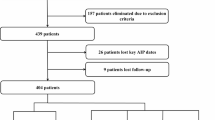Abstract
Nilotinib is currently approved for the treatment of chronic myeloid leukemia (CML) in chronic (CP) and accelerated phase (AP) after failure of imatinib and in newly diagnosed patients. Atherosclerotic events were retrospectively reported in patients with baseline cardiovascular risk factors during nilotinib treatment. We estimated the risk of developing atherosclerotic events in patients treated with second or first-line nilotinib, with a median follow-up of 48 months, by retrospectively applying the SCORE chart proposed by the European Society of Cardiology (ESC) and evaluating risk factors at baseline (diabetes, obesity, smoking, and hypertension). Overall, we enrolled in the study 82 CP patients treated frontline (42 CP patients at the dose of 600 mg BID) or after failure of other tyrosine kinase inhibitors (40 CP patients treated with 400 mg BID). The SCORE chart is based on the stratification of sex (male vs female), age (from 40 to 65 years), smoker vs non-smoker, systolic pressure (from 120 to 180 mm Hg), and cholesterol (measured in mmol/l, from 150 to 300 mg/dl). For statistical purposes, we considered patients subdivided in low, moderate, high (with a score >5), and very high risk. There were 48 males and 34 females, median age 51 years (range 22–84). According to WHO classification, 42 patients were classified as normal weight (BMI <25), 26 patients were overweight (BMI 26 ≤ 30), and 14 were obese (BMI >30). Retrospective classification according to the SCORE chart revealed that 27 patients (33 %) were in the low-risk category, 30 patients (36 %) in the moderate risk category, and 24 patients (29 %) in the high risk. As regards risk factors, we revealed that 17 patients (20.7 %) had a concomitant type II controlled diabetes (without organ damage), 23 patients (28 %) were smokers, 29 patients (35 %) were receiving concomitant drugs for hypertension, and 15 patients (18 %) had concomitant dyslipidemia. Overall, the cumulative incidence of atherosclerotic events at 48 months was 8.5 % (95 % CI, 4.55–14.07): None of the low-risk patients according to the SCORE chart experienced atherosclerotic events compared to 10 % in the moderate risk category and 29 % in the high risk (p = 0.002). Atherosclerotic-free survival was 100, 89, and 69 % in the low, moderate, and high-risk population, respectively (p = 0.001). SCORE chart evaluation at disease baseline could be a valid tool to identify patients at high risk of atherosclerotic events during nilotinib treatment.
Similar content being viewed by others
References
Larson RA, Hochhaus A, Hughes TP, Clark RE, Etienne G, Kim DW et al (2012) Nilotinib vs imatinib in patients with newly diagnosed Philadelphia chromosome-positive chronic myeloid leukemia in chronic phase: ENESTnd 3-year follow-up. Leukemia 26:2197–2203
Saglio G, Hochhaus A, Hughes TP, Clark RE, Nakamae H, Kim DW et al (2013) ENESTnd update: nilotinib vs imatinib in patients with newly diagnosed chronic myeloid leukemia in chronic phase and the impact of early molecular response and Sokal risk at diagnosis on long-term outcomes. Blood 114:632
Aichberger KJ, Herndlhofer S, Schernthaner GH, Schillinger M, Mitterbauer-Hohendanner G, Sillaber C, Valent P (2011) Progressive peripheral arterial occlusive disease and other vascular events during nilotinib therapy in CML. Am J Hematol 86:533–539
le Coutre P, Rea D, Abruzzese E, Dombret H, Trawinska MM, Herndhofer S et al (2011) Severe peripheral arterial disease during nilotinib therapy. J Natl Cancer Inst 103:1347–1348
Giles F, Mauro MJ, Hong F, Ortmann CE, McNeill C, Woodman RC et al (2013) Rate of peripheral arterial occlusive disease in patients with chronic myeloid leukemia in the chronic phase treated with imatinib, nilotinib, or non-tyrosine kinase therapy: a retrospective cohort analysis. Leukemia 27:1310–1315
Kim TD, Rea D, Schwarz M, Grille P, Nicolini FE, Rosti G et al (2013) Peripheral artery occlusive disease in chronic phase chronic myeloid leukemia patients treated with nilotinib or imatinib. Leukemia 27:1316–1321
le Coutre P, Hughes T, Mahon FX, Kim DW, Steegmann JL, Shah NP et al (2013) Peripheral arterial occlusive disease (PAOD) in patients (pts) receiving dasatinib: experience across multiple clinical trials. Blood 122:1489
Perk J, De Backer G, Gohlke H, Graham I, Reiner Z, Verschuren WM et al (2012) European guidelines on cardiovascular disease prevention in clinical practice (version 2012): the fifth joint task force of the European society of cardiology and other societies on cardiovascular disease prevention in clinical practice (constituted by representatives of nine societies and by invited experts). Int J Behav Med 19:403–488
Saglio G, Larson RA, Hughes TP, Issaragrisil S, Turkina AG, Marin D et al (2010) Efficacy and safety of nilotinib in chronic phase chronic myeloid leukemia patients with type 2 diabetes in the ENESTnd trial. Blood 116:3430
Rea D, Gautier JF, Breccia M, Saglio G, Hughes TP, Kantarjian H et al (2012) Incidence of hyperglycemia by 3 years in patients with newly diagnosed of chronic myeloid leukemia in chronic phase treated with nilotinib or imatinib in ENESTnd. Blood 120:1686
Hiwase DK, Carne L, Ross D, Grigg A, Hughes TP (2013) Hypercholesterolemia in imatinib intolerant/resistant CML-CP patients treated with nilotinib: a retrospective analysis. Blood 122:1503
Rea D, Mirault T, Gaultier JF, Guilhot F, Messas E, Dombret H (2013) Prospective analysis of plasma cholesterol and triglycerides in patients with chronic phase-chronic myeloid leukemia during treatment with the 2nd generation tyrosine kinase inhibitor nilotinib. Blood 122:4042
Conflict of interest
The authors declare that they have no conflict of interest.
Informed consent
Informed consent was obtained from all patients for being included in the study.
Author information
Authors and Affiliations
Corresponding author
Rights and permissions
About this article
Cite this article
Breccia, M., Molica, M., Zacheo, I. et al. Application of systematic coronary risk evaluation chart to identify chronic myeloid leukemia patients at risk of cardiovascular diseases during nilotinib treatment. Ann Hematol 94, 393–397 (2015). https://doi.org/10.1007/s00277-014-2231-9
Received:
Accepted:
Published:
Issue Date:
DOI: https://doi.org/10.1007/s00277-014-2231-9




